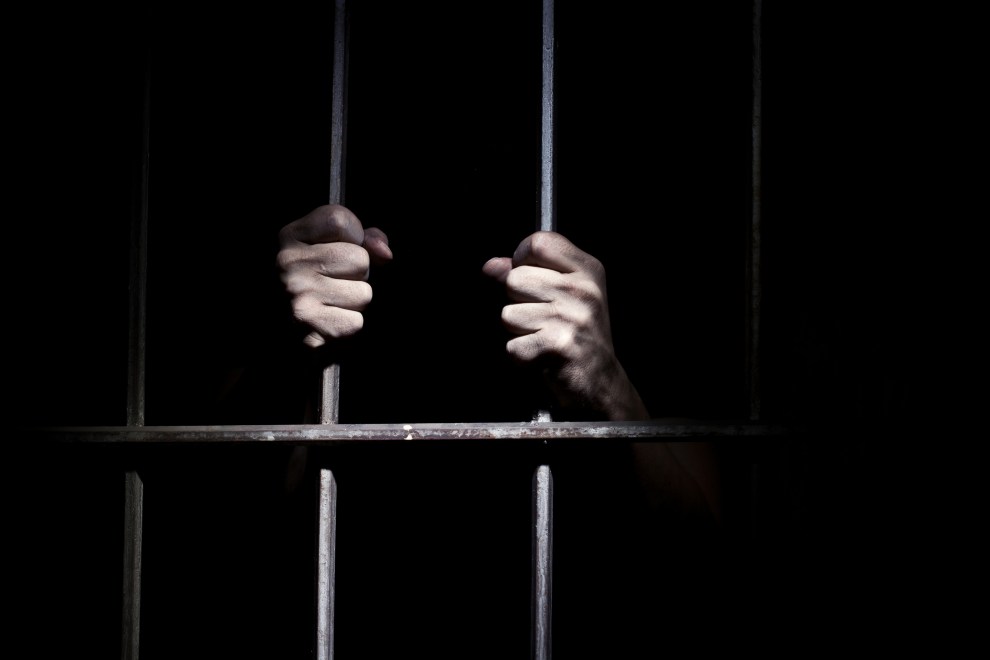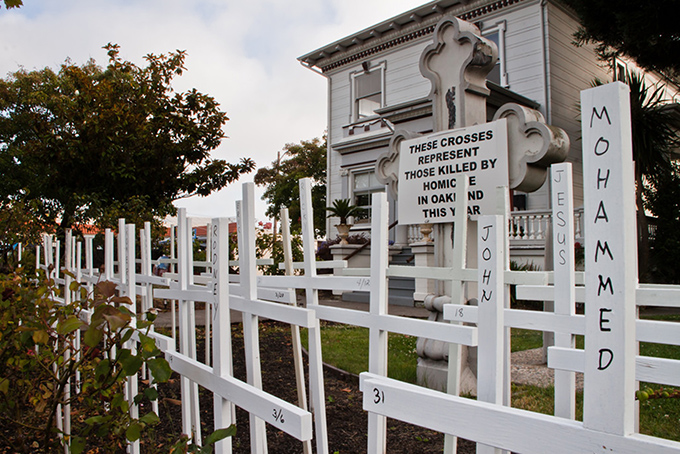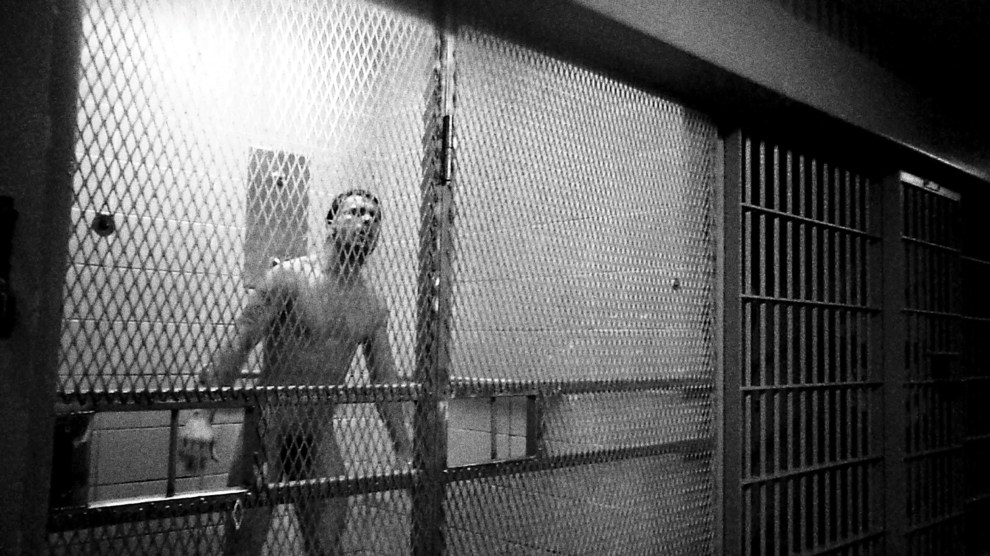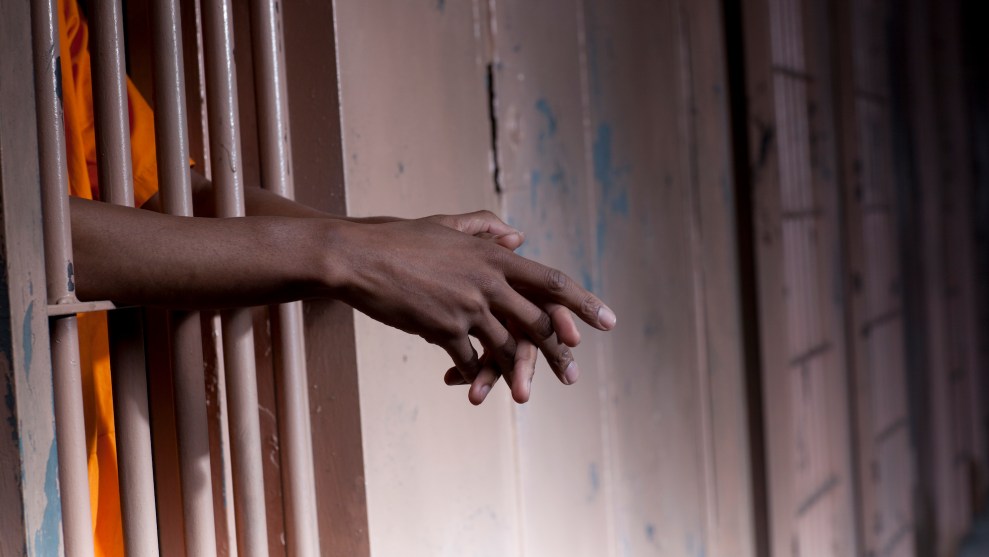
<a href="http://www.shutterstock.com/pic-86779999/stock-photo-hands-of-the-prisoner-on-a-steel-lattice-close-up.html?src=7rCqqPhhbHXIyL_2b8w2oQ-1-2"> BortN66</a>/Shutterstock
This story first appeared on the TomDispatch website.
Once upon a time I was a journalist, covering wars in Indochina, Central America, and the Middle East. I made it my job to write about the victims of war, the civilian casualties. To me, they were hardly “collateral damage,” that bloodless term the military persuaded journalists to adopt. To me, they were the center of war. Now I’m a private eye. I work mostly on homicide cases for defense lawyers on the mean streets of Oakland, California, long viewed as one of America’s murder capitals.
Indeed, on some days Oakland feels like Saigon, Tegucigalpa, or Gaza. There’s the deception of daily life and the silent routine of dread punctured by out-of-the-blue mayhem. The city’s poorest neighborhoods are sporadic war zones whose violence sometimes explodes onto streets made rich overnight by the tech boom. On any quiet day, you can drive down San Pablo Avenue past St. Columba Catholic Church, where a thicket of white crosses, one for every Oaklander killed by gun violence in a given year, crowds its front yard.

Whenever I tell people I’m a private eye, they ask: “Do you get innocent people off death row?” Or “Can you follow my ex around?” Or “What kind of gun do you carry?”
I always disappoint them. Yes, I do defend people against the death penalty, but so far all my defendants have probably been guilty—of something. (Often, I can only guess what.) While keeping them off death row may absolve me of being an accessory after the fact to murder, it also regularly condemns my defendants to life in prison until they die there.
And I find spying on people their ex-spouses fantasize about killing much sleazier than actual murder. Finally, I’m a good shot, but I don’t carry a gun because that’s the best way to get shot. I work on the low-profile cases: poor people charged with murder, burglary, or robbery, who don’t have the money for a lawyer or their own P.I. (I’m paid, if you can call it that, by the state.)
Then people invariably want to know, “How can you help defend a murderer?” The law school answer is: The constitution guarantees everyone a fair trial. For me, however, if it’s a death penalty case, it’s simple: I’m against the death penalty no matter what the accused did (or didn’t do). But in this age of stop and frisk, racial profiling, mandatory sentencing, the death penalty, and life without parole—not to mention execution by cop—the real answer is: I can’t. Defend anybody, that is. Not really.
I’m just a tiny cog in America’s vast Criminal Injustice System. One of the lawyers I work for sometimes calls himself “just a potted plant.” My defendants may be guilty—but seldom of what they are charged with. They are rarely convicted of what they actually did and are never sentenced fairly.
One day recently, I was getting ready to hit the streets in search of a witness to a murder when I found in my email Justice Sonia Sotomayor’s dissent in the Supreme Court Case of Utah v. Strieff. It had been forwarded by a psychologist with whom I once worked on a death penalty case.
Anyone lulled into thinking the new coalition of liberals and conservatives who hope to reform the criminal justice system will actually get somewhere should read Strieff. The facts are the following: A Salt Lake City cop was watching a home rumored to house methamphetamine dealers. When Edward Joseph Strieff left the house, the cop stopped him, questioned him, and checked his record. When the cop found a warrant for an unpaid parking ticket, he searched Strieff, found meth in his pockets, and arrested him for possession.
In Strieff and other cases leading up to it, the Supreme Court has now decreed that evidence gathered in an illegal search isn’t “the fruit of the poisoned tree,” as Justice Felix Frankfurter put it in 1939, and so no longer must be suppressed. Even though gathered illegally, evidence can be used at trial against a defendant. In short, stop-and-frisk policing and racial profiling, key targets of the new civil rights movement, just got a stamp of approval from the highest court in the land.
Justices Ruth Bader Ginsburg and Elena Kagan also dissented. But it was Justice Sotomayor who sounded the alarm in an opinion evoking nothing less than James Baldwin’s The Fire Next Time and adding quotations from W.E.B. Du Bois, Ta-Nehisi Coates, and Michelle Alexander for good measure. She wrote:
“The Court today holds that the discovery of a warrant for an unpaid parking ticket will forgive a police officer’s violation of your Fourth Amendment rights. Do not be soothed by the opinion’s technical language: this case allows the police to stop you on the street, demand your identification, and check it for outstanding traffic warrants—even if you are doing nothing wrong. If the officer discovers a warrant for a fine you forgot to pay, courts will now excuse his illegal stop and will admit into evidence anything he happens to find by searching you after arresting you on the warrant. Because the Fourth Amendment should prohibit, not permit, such misconduct, I dissent.”
Sotomayor concluded:
“This case tells everyone, white and black, guilty and innocent, that an officer can verify your legal status at any time. It says that your body is subject to invasion while courts excuse the violation of your rights. It implies that you are not a citizen of a democracy but the subject of a carceral state, just waiting to be catalogued.
“We must not pretend that the countless people who are routinely targeted by police are ‘isolated.’ They are the canaries in the coal mine whose deaths, civil and literal, warn us that no one can breathe in this atmosphere.”
Her dissent describes daily existence for my defendants. Too poor to buy car insurance, fix broken tail lights, pay parking tickets, or get green cards, they are always on high alert for the police. (Alice Goffman’s brilliant study, On the Run: Fugitive Life in an American City, describes just how it works in one of Philadelphia’s poorest neighborhoods.) My defendants have been sentenced to life in a war zone even before they find themselves charged in court. They have been sentenced to a life without parole or sometimes to death, caught as they are in a crossfire between cops and warring neighborhood gangstas.
A warrant for, say, unpaid parking tickets discovered in a Strieff-approved stop gets you a search of yourself and your car by police and maybe a bust for weed, the intoxicant of choice for many of the poor. If you object or run or the arresting officer is having a bad day, it may get you dead. (Refusing to pay protection money to your neighborhood punks or standing on the wrong corner at the wrong time may do the same.)
Once you’re arrested, if you say you want a lawyer, you get a public defender with so many cases she or he may not even be able to meet you or read the complaint against you before you appear in court. You may serve weeks or months in jail, even if you’re innocent, before your case is heard, and years before you are tried.
A district attorney has a whole police department to use to investigate a crime (although the Oakland Police Department, which I’m often up against, solves only 27 percent of its murder cases, and so is not exactly the most formidable of foes). (A recent investigation by the East Bay Express suggests that some Oakland cops are too busy hooking up with underage prostitutes to solve murders.) But if a DA needs to find a witness, the OPD’s army of street cops can often locate him through their confidential informants. Or they can pull him in on a warrant for those unpaid parking tickets, threaten a drug bust or revocation of his parole or probation, or hold him as a material witness if he resists cooperating.
At best, a defendant gets just me—and most of the accused don’t get an investigator at all. The landmark 1963 Supreme Court case Gideon v. Wainwright may have given poor defendants the right to an attorney, but there is no legal right to an investigator (except in death penalty cases). And unlike a DA, no one has to talk to me or face trouble with the law. I have no muscle. But I have been known to find a witness who doesn’t want to be found and nag him or her into submission.
In the last 10 years, in cases mostly in Northern California, among scores of people I’ve helped defend, only three have been white—and they were as destitute as the poor blacks and Latinos who jam American jails and prisons.
Defense teams I’ve been on start off by guessing if and why the accused might have done what he’s charged with. It’s human nature to do so. But if the accused is pleading not guilty, it’s better not to know. “I don’t know what happened, I wasn’t there,” one death penalty lawyer I work with regularly says to shut off such speculation. As for the why, the shrinks often can’t help, even if you call on them to testify. Decades of research into the criminal mind often comes down to: “He snapped.” That’s not a good line for a jury, but it’s the kicker to many a defense meeting.
In a real trial, the truth of what actually happened doesn’t matter anyway. Only the truth of the evidence counts.
Are poverty, racism, and a desperate childhood a defense? Prosecutors love to face this argument. They get on their high horses and trot out the American dream and all the poor people who suck up their rage and despair and don’t murder someone. All the folks who don’t snap.
But in California, what might have caused someone to snap isn’t admissible at trial anyway, except in death penalty cases. A “diminished capacity” defense was abolished in 1981 after ex-San Francisco Supervisor Dan White used one to beat a murder rap for killing Supervisor Harvey Milk and Mayor George Moscone. The jury bought his lawyer’s argument—which came to be known as the “Twinkie defense”—that White was addled by junk food when he killed the two of them. It ignored evidence that White intended and planned the murder, taking his gun to City Hall, climbing through a window to avoid metal detectors, and reloading it after first shooting Moscone.
These days, only in the penalty phase of a death penalty case—when the jury decides whether the defendant they’ve just found guilty will face capital punishment or life in prison without parole—can defense lawyers present evidence of the tragic facts of the defendant’s life. The jury may then hear of his years in foster care, his mom the crack addict, his dad absent in prison, and the older brother who initiated him into street life. Only then will the jury be asked to see the accused as a person with a life beyond the crime with which he is charged. The defense will finally replace a prosecutor’s blown-up mug shot of the defendant and Facebook screen shots of him showing off a gun with family photos of him at his sixth birthday party decked out in a silly hat and others of his toddler and baby mama.
Most jurors don’t much like this defense. They assume it’s just an excuse. But it’s not. It’s an explanation.
Take Larry. He’s an OG (original gangsta, or old guy), a 50-year-old African American man who grew up in dire poverty in Deep East, Oakland’s most murderous neighborhood. Larry has symptoms of schizophrenia but has never been able to get real mental health care. He’s been living, on and off, with his mother who is also schizophrenic in Acorn (“The ‘Corn”), one of the toughest housing projects in West Oakland. His mother is too afraid of its gangbangers to leave her apartment. Larry recently told a counselor at a walk-in clinic for the poor that he thought he had PTSD from all the shooting and killing he’s witnessed.
Like many poor Oaklanders, he makes his meager living in the underground economy, dealing small amounts of weed to regular customers who phone him on his cell. While cellphones have made it possible to sell drugs without the turf battles of the past, The ‘Corn is ruled by a gang of young punks called the Acorn Mob and their rivals, the Gashouse Team. The Mob doesn’t just support itself moving guns or drugs. It also makes money ripping off small-time dealers like Larry, demanding protection money from neighborhood people, and robbing the elderly when they cash their social security checks.
Like many poor people living on such mean streets, Larry is always looking over his shoulder. A simple walk down the block might mean being rolled by the Mob, accosted by police, or caught in the crossfire of someone else’s feud.
In early 2012, Larry’s life dropped off a cliff. His brother died of cancer; his daughter died in a freak case of emergency room malpractice; he witnessed a friend gunned down in a gang battle; and he was robbed at gunpoint on a street near The ‘Corn. Meanwhile, the Acorn Mob was stepping up pressure on OGs like Larry to pay them protection money.
As Larry tells it, one morning that August, two of the most vicious Mob gangbangers dogged him on the streets around The ‘Corn, demanding to know when he’d take up a collection from his OG buddies to pay them off. He took shelter along with his crew in a friend’s apartment in one of the project’s towers. When he told his friends about the latest threats, the group debated what to do, damping their fears by smoking weed and drinking mai tais.
Later, near dark, Larry and his friend Arthur wandered over to the local liquor store to buy the cigarillos they filled with weed to make blunts. On the way, the same two Acorn Mob punks who had accosted them earlier that day threatened to kill Larry if he didn’t come up with some money fast. Larry and Arthur sought refuge in the store, but one of the young thugs followed them inside. The other waited outside the door.
Larry had had enough. He snapped. He grabbed an old handgun Arthur carried for protection and ran out of the store. He says he fired once, hoping to scare off the two of them. That started a volley of wild shots. When Arthur’s gun jammed, Larry ran back inside the liquor store. As soon as the shooting stopped, Larry and Arthur split the neighborhood. Somehow in the melee, one of the Acorn mobsters was shot and later died at the county hospital.
Larry and Arthur were arrested some months later. Larry was charged with murder and Arthur with being a felon with a gun and an accessory with knowledge of a crime. Word on the street was that the victim had been killed accidently by his own cousin, the gangsta who had followed Larry into the liquor store. Even the victim’s stepfather told me he believed that. But no witness—and there were many standing outside the liquor store during the melee, including several of Larry’s buddies—would come forward. They all had records, were doing drugs, and were afraid of the police.
Six cartridges from one gun and a single cartridge from another were found in the street near the body. Neither gun was ever found. The victim had suffered a “through and through” wound, which meant there were no bullet fragments to match to a particular gun anyway.
California’s self-defense and provocation laws—unlike Florida’s “stand your ground law,” which figured in George Zimmerman’s killing of Trayvon Martin—are very strict. Larry’s lawyer worried that a judge would rule self-defense couldn’t be justified because Larry had fired the first shot (even if it was, as he claimed, in the air). His possible PTSD, the recent dire tragedies in his personal life, the pressures of Oakland’s mean streets, the fact that his mind was addled by weed and mai tais—all would be irrelevant in a California trial.
So Larry didn’t have the luxury of a Twinkie defense. He feared a jury. No poor person gets a jury of his or her peers. Few poor people are called for jury duty because the lists of potential jurors are made up from voter and driver’s license records; few poor people living the fugitive life vote and many don’t have a driver’s license. Coming to court might mean being stopped and frisked by the police. (I’ve had a defense witness arrested on a warrant while waiting to testify outside court and others who have been followed home by the police after they showed up to support a family member on trial.) No prosecutor would permit anyone on a jury who’s led the kind of life Larry has—someone with a drug record (even if 20 years old), or who understood life and death in Oakland’s war zones firsthand.
Larry feared mandatory sentencing, which severely restricts a judge’s ability to vary a sentence by taking into consideration mitigating facts in a particular person’s life like Larry’s clean record for the last 20 years, his possible PTSD, or the daily grind of violence in The ‘Corn. That meant he was facing 25 years to life if convicted of murder. For defending himself. For firing one shot when it wasn’t even clear who had killed the victim.
Larry took a plea to a killing he may not have done. Voluntary manslaughter with a mandatory sentence of 12 years in prison.
The Acorn Mob youngster who threatened Larry in the liquor store that August night and probably fired the fatal round was soon arrested for many armed robberies and sent to prison for 15 years.
I saw Larry right before he left the county jail for prison. I apologized for not being able to defend him. He thanked me for trying and added, “It ain’t just, but that’s how they do.”
Former journalist Judith Coburn, who has written for Mother Jones and many other outlets, became a P.I. 10 years ago.















